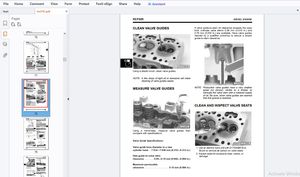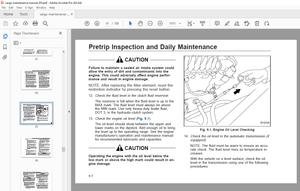$38
Maeda MINI CRANE MC-285 OPERATING MANUAL – PDF DOWNLOAD (English)
Maeda MINI CRANE MC-285 OPERATING MANUAL – PDF DOWNLOAD (English)
FILE DETAILS:
Maeda MINI CRANE MC-285 OPERATING MANUAL – PDF DOWNLOAD (English)
Language : Russian,
Pages :216
Downloadable : Yes
File Type : PDF
TABLE OF CONTENTS:
Maeda MINI CRANE MC-285 OPERATING MANUAL – PDF DOWNLOAD (English)
INTRODUCTION
1. Introduction 1-2
2. Safety Precautions 1-3
3. Brief Description of the Machine 1-4
3.1. Intended Use 1-4
3.2. Crane Configuration 1-4
3.3. Features Equipped with the Crane 1-5
4. Operator Qualification Requirements 1-6
4.1. Qualifications of Crane Operators 1-6
5. Glossary 1-7
5.1. Definition of Terms 1-7
5.2. How to Read the Working Range Chart: Working Radius and Lifting Height 1-8
5.3. How to Read the Total Rated Capacity Table 1-9
5.4. How to Read the Load Indicator 1-14
SAFETY PRECAUTIONS
1. General Rules 2-2
2. Operating Rules 2-8
2.1. Before Starting the Engine 2-8
2.2. After Starting the Engine 2-9
2.3. When Working with the Crane 2-13
3. Rules for Transporting the Crane 2-21
4. Handling the Battery 2-23
5. Repairing the Crane 2-25
5.1. Before Repairing 2-25
5.2. During Repairs and Maintenance 2-25
6. Hanging Up Warning Signs 2-37
OPERATION 3-2
1 List of Main Crane Components 3-2
1.2. Main Travel Control Devices 3-3
1.2.1. Control Levers 3-4
1.2.2. Switches 3-6
1.2.3. Instrumentation and Switches 3-7
1.3. Elements of the Crane Control System 3-9
1.3.1. Control Levers 3-10
1.3.2. Switches 3-11
1.3.3. Instrumentation and Lamps 3-13
1.4. Overload Warning System 3-14
1.5. Machine Hood 3-15
1-16
2. Operation and Controls 3-16
2.1. Before Starting the Engine 3-16
2.1.1. Roundabout Inspection 3-16
2.1.2. Prestart Checks 3-18
2.2. Starting the Engine 3-37
2.2.1. Starting the Engine with the Main Starter Switch 3-37
2.2.2. Starting the Engine with the Main Starter Switch in
Cold Weather
3-38
2.2.3. Starting the Engine with the Auxiliary Starter Switch 3-39
2.3. Operation and Checks After Starting the Engine 3-40
2.4. Running-in Run. 3-42
2.5. “Travel” Position. 3-42
2.6. Starting the Machine. 3-43
2.7. Changing the Travel Direction. 3-44
2.8. Stopping and Parking the Crane. 3-45
2.9. Stopping the Engine. 3-46
2.10. Inspection and Checks after Stopping the Engine. 3-46
2.11. Crane Movement Rules. 3-47
2.12. Installing the Extendable Outriggers. 3-48
2.13. What You Need to Know Before Operating the Crane 3-53
2.14. Pre-Operation Procedures 3-54
2.15. Crane Operating Position 3-55
2.16. Load Raising and Lowering Operations 3-56
2.17. Raising and Lowering the Boom 3-56
2.18. Boom Extension (Telescoping) Operations 3-57
2.18. Boom Extension (Telescoping) Operations 3-57
2.19. Swing Operations 3-58
2.20. Accelerator Pedal Operations 3-59
2.21. How to Use the Load Indicator and Load Cell 3-60
2.22. Laying Down the Crane 3-63
2.23. Folding the Outriggers 3-64
2.24. Prohibited Actions When Working on the Crane 3-67
3. Handling Rubber Tracks 3-69
3.1. Proper Handling of Rubber Tracks 3-69
3.2. Warranty 3-69
3.3. Prohibited Work 3-70
3.4. Operating Rules 3-71
4. Using the Rope 3-73
4.1. Rope Replacement Standards 3-73
4.2. Actions in Case of Rope Twisting 3-74
5. Transportation 3-75
5.1. Loading and Unloading 3-75
5.2. How to Lift the Machine 3-76
5.3. Loading Rules 3-77
5.4. Transport Rules 3-77
6. Handling the Crane in Cold Climates 3-78
6.1. Preparing for Low Ambient Temperatures 3-78
1-17
7. Long-Term Storage 3-80
7.1. Preparing for Long-Term Storage 3-80
7.2. During Storage 3-80
7.3. After Storage 3-80
8. Handling the Battery 3-81
8.1. Handling the Battery 3-81
8.2. Removing and Installing the Battery 3-82
8.3. Replacing the Battery 3-82
8.4. Starting with Jumper Cables 3-83
9. Action to Take in the Event of a Malfunction 3-85
9.1. When Connecting to Electrical Components 3-85
9.2. In Connection with the Machine 3-85
9.3. In Connection with the Engine 3-86
MAINTENANCE
1. Carrying Out Repairs 4-2
2. Basics of Repair and Maintenance 4-4
3. Inspection Required by Law 4-6
3.1 Rules for Safe Inspection of the Crane 4-6
4. Consumables 4-7
5. Lubricating Oil and Grease 4-8
5.1 Lubricants Used at Different Temperatures 4-8
6. Standard Tools and Standard Tightening Torque 4-9
6.1 Summary of Standard Tools 4-9
6.2 Standard Tightening Torque Table 4-9
7. Scheduled Maintenance 4-12
8. Repair Procedure 4-14
8.1 After the First 10 Hours of Operation 4-14
8.2 After the First 50 Hours of Operation 4-14
8.3 After the First 250 Hours of Operation 4-14
8.4 If Necessary 4-15
8.5 Checking Before Starting 4-21
8.6. After every 30 operating hours 4-40
8.7. After every 50 operating hours 4-42
8.8. After every 100 operating hours 4-45 8.9
. After every 250 operating hours 4-46
8.10. After every 500 operating hours 4-48
8.11. After every 1,000 operating hours 4-55
8.12. After every 2,000 operating hours 4-63
1-18
SPECIFICATIONS
1. Main Technical Data and Specifications 5-2
1.1. Specification Table 5-2
1.2. Overall Dimensions 5-3
1.3. Total Rated Load Table 5-4
1.4. Working Radius/Lifting Height Diagram
IMAGES PREVIEW OF THE MANUAL:





